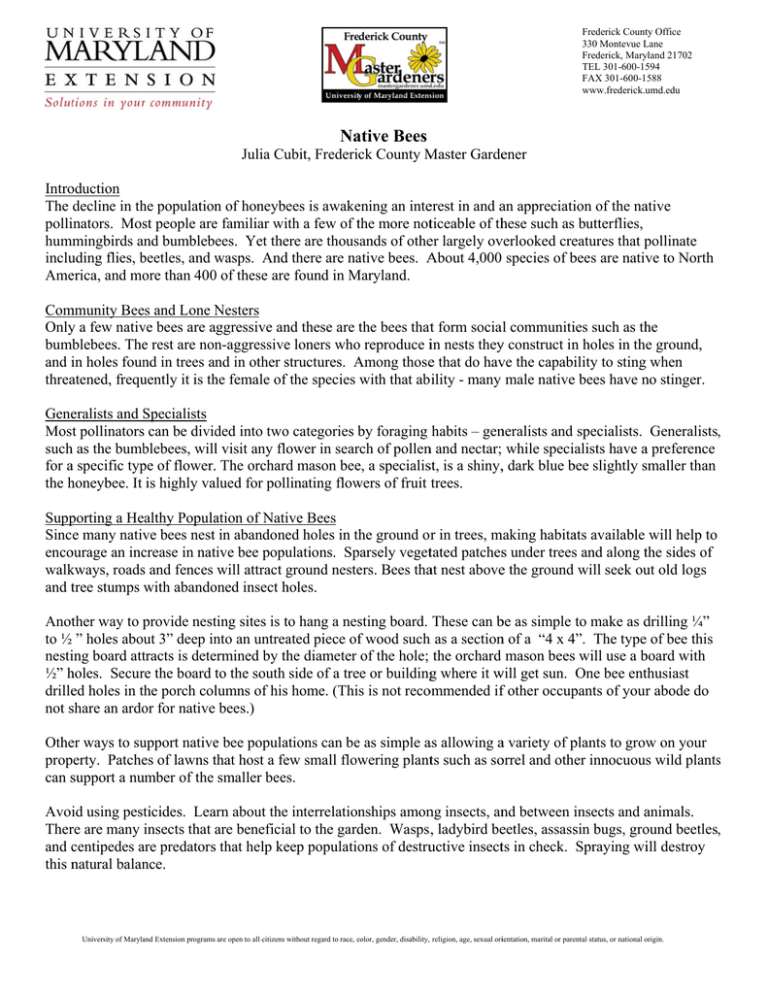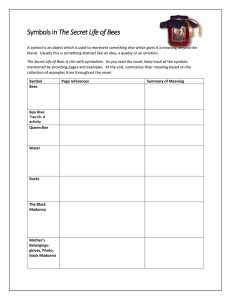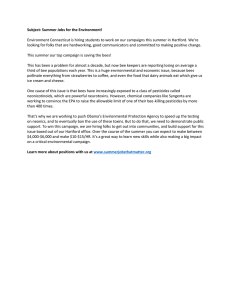Julia Cu Intro oduction
advertisement

Frederick Countty Office 330 Montevue L Lane Frederick, Maryyland 21702 TEL 301-600-15594 FAX 301-600-1588 www.frederick.uumd.edu Na ative Bees Julia Cu ubit, Fredericck County M Master Gardeener Introoduction The decline in th he population n of honeybeees is awakeening an inteerest in and aan appreciatiion of the naative polliinators. Mosst people aree familiar wiith a few of the t more notticeable of thhese such ass butterflies, hum mmingbirds and bumblebees. Yet theere are thousands of otheer largely ovverlooked creeatures that ppollinate incluuding flies, beetles, b and wasps. w And d there are naative bees. A About 4,000 species of bbees are nativve to North Ameerica, and mo ore than 400 0 of these aree found in Maryland. M Com mmunity Beees and Lone Nesters N Onlyy a few nativ ve bees are aggressive a an nd these are the t bees thatt form social communitiies such as thhe bum mblebees. Thee rest are non n-aggressivee loners who o reproduce iin nests theyy construct inn holes in the ground, and iin holes foun nd in trees an nd in other structures. s Among A thosee that do havve the capabiility to stingg when threaatened, frequ uently it is th he female off the species with that ab ility - many male nativee bees have nno stinger. S Geneeralists and Specialists Most pollinatorss can be divid ded into two o categories by b foraging habits – genneralists and specialists. Generalists, suchh as the bumb blebees, willl visit any flo ower in searrch of pollenn and nectar; while specialists have a preference for a specific typ pe of flower.. The orchard d mason beee, a specialisst, is a shiny,, dark blue bbee slightly ssmaller than the hhoneybee. It is highly vaalued for polllinating flow wers of fruit trees. Suppporting a Healthy Populaation of Natiive Bees Since many nativ ve bees nest in abandoneed holes in th he ground orr in trees, m making habitaats available will help to encoourage an inccrease in nattive bee popu ulations. Sp parsely vegettated patchess under treess and along tthe sides of walkkways, roadss and fences will attract ground g nesteers. Bees thaat nest abovee the ground will seek ouut old logs and ttree stumps with abando oned insect holes. h p nestting sites is to t hang a nessting board. These can bbe as simple to make as ddrilling ¼” Anotther way to provide to ½ ” holes about 3” deep in nto an untreaated piece off wood suchh as a sectionn of a “4 x 44”. The typee of bee this nestiing board atttracts is deteermined by th he diameter of the hole; the orchard mason beess will use a bboard with ½” hholes. Securre the board to t the south side of a treee or buildingg where it w will get sun. One bee entthusiast drilleed holes in the porch collumns of hiss home. (This is not recoommended iff other occuppants of yourr abode do not sshare an ardo or for native bees.) Otheer ways to su upport nativee bee populaations can bee as simple aas allowing a variety of pplants to grow w on your propperty. Patchees of lawns that t host a feew small flow wering plantts such as soorrel and other innocuous wild plantss can ssupport a nu umber of the smaller bees. nships amonng insects, annd between iinsects and aanimals. Avoiid using pestticides. Leaarn about thee interrelation Therre are many insects that are a beneficiaal to the gard den. Wasps,, ladybird beeetles, assasssin bugs, groound beetles, and ccentipedes are a predatorss that help keeep populatio ons of destruuctive insectts in check. Spraying wiill destroy this nnatural balan nce. University of Marylaand Extension programs are open to all citizens without w regard to race, color, c gender, disability, religion, age, sexual oriientation, marital or pareental status, or national oorigin. Consider choosing native perennials when selecting new plants. Native insects have evolved alongside native plants and native birds. Native plants will attract native insect pollinators such as bees and butterflies. In turn, these insects will attract songbirds which will help maintain overall insect populations at a healthy level. Websites An excellent source of information about native pollinators and native plants can be found at www.pollinator.org. Select the guide for the Eastern Broadleaf Forest, Oceanic Province which has detailed information for Maryland. For more information about the Frederick County Master Gardener/Horticulture Program, visit www.frederick.umd.edu/mg or call Susan Trice at the University of Maryland Extension Frederick County office, 301-600-1596. Find us on Facebook at http://www.facebook.com/mastergardenersfrederickcountymaryland University of Maryland Extension programs are open to all citizens without regard to race, color, gender, disability, religion, age, sexual orientation, marital or parental status, or national origin.






